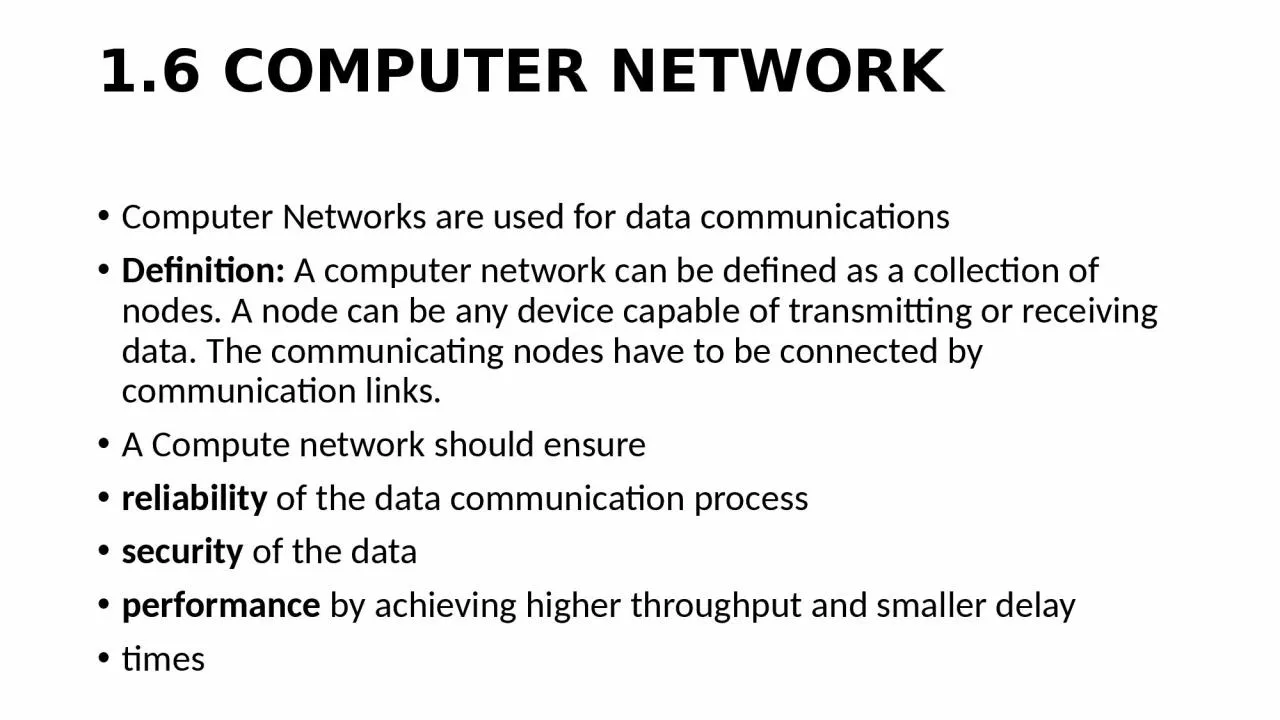

Networks are used for data communications Definition A computer network can be defined as a collection of nodes A node can be any device capable of transmitting or receiving data The communicating ID: 1021152
Download Presentation The PPT/PDF document "1.6 COMPUTER NETWORK Computer" is the property of its rightful owner. Permission is granted to download and print the materials on this web site for personal, non-commercial use only, and to display it on your personal computer provided you do not modify the materials and that you retain all copyright notices contained in the materials. By downloading content from our website, you accept the terms of this agreement.
1. 1.6 COMPUTER NETWORK Computer Networks are used for data communications Definition: A computer network can be defined as a collection of nodes. A node can be any device capable of transmitting or receiving data. The communicating nodes have to be connected by communication links. A Compute network should ensure reliability of the data communication process security of the dataperformance by achieving higher throughput and smaller delay times
2. 1.6.1 Categories of Network Networks are categorized on the basis of their size. The three basic categories of computer networks are: A. Local Area Networks (LAN) is usually limited to a few kilometers of area. It may be privately owned and could be a network inside an office on one of the floor of a building or a LAN could be a network consisting of the computers in a entire building. B. Wide Area Network (WAN) is made of all the networks in a (geographically) large area. The network in the entire state of Maharashtra could be a WAN. C. Metropolitan Area Network (MAN) is of size between LAN & WAN. It is larger than LAN but smaller than WAN. It may comprise the entire network in a city like Mumbai.
3. 1.7 PROTOCOL A Protocol is one of the components of a data communications system. Without protocol communication cannot occur. The sending device cannot just send the data and expect the receiving device to receive and further interpret it correctly. When the sender sends a message it may consist of text, number, images, etc. which are converted into bits and grouped into blocks to be transmitted and often certain additional information called control information is also added to help the receiver interpret the data. For successful communication to occur, the sender and receiver must agree upon certain rules called protocol. A Protocol is defined as a set of rules that governs data communications. A protocol defines what is to be communicated, how it is to be communicated and when it is to be communicated.
4. 1.7.1 Elements of a Protocol There are three key elements of a protocol: A. Syntax: It means the structure or format of the data. It is the arrangement of data in a particular order. B. Semantics : It tells the meaning of each section of bits and indicates the interpretation of each section. It also tells what action/decision is to be taken based on the interpretation. C. Timing t tells the sender about the readiness of the receiver to receive the data It tells the sender at what rate the data should be sent to the receiver to avoid overwhelming the receiver.
5. Data Transmission Analog and Digital Transmission:- Data can be transmitted either in the form of analog and digital data or analog and digital signal using Analog / Digital Transmission. Analog Data and Digital Data Data :- data are raw facts that are meaningless . they are processed to form Information .
6. Analog Data :- Data that is continuous and have magnitude directly proportional to the data function is known as analog data . it is generally used to transmit real time data such as audio and video which changes the pattern of signal depending on intensity . Digital Data :- Data that uses discrete or uneven spectrum that if there is no continuity in data , then it is called Digital Data . it is used for transmitting text , integers or string of characters . it can be send , received and recreated no loss of content . data in digital form is represented in the form of binary number 0 and 1 .
7. Analog Signal and Digital Signal Signal :- signals are the physical representation of data . data is exchanged in the form of signal through the transmission media . signals can be in the form of electrical impulse , radio wave or electromagnetic waves . signal can either be analog signal or digital signal . Analog Signal :- Analog Signal is continuous signal that depends on intensity. Analog Signal is transmitted in the form of electromagnetic waves over the transmission media which is either guided transmission media such as twisted pair , coaxial cable or unguided media that include satellite communication , terrestrial microwave . Analog Signals are easily effected by noise that decrease the resolution of Analog Signal. Analog Signals are represented using sine waves .
8. Digital Signal:- Digital Signals are discrete signals that are independent of time and intensity . Digital Signals are transmitted in the form of sequence voltage pulses represented in binary form containing (0,1). Unlike analog signals that changes over a period of time, digital signals remain static and value of signals noted at fixed interval rather than using continuous interval. Digital Signals are not easily affected by an non linearity such as noise. Error in Digital Signal can be detected and corrected which is not possible in analog signals.
9. Advantages of Digital Signal:- - Inexpensive than analog signals . - Digital Signals are not affected or harmed due to noise interference . Disadvantages of Digital Signal:- Attenuation impairment is the major Advantages of Digital Signal, due to which the strength of signal is degraded which can result in loss of data at receiving end .
10. Any question